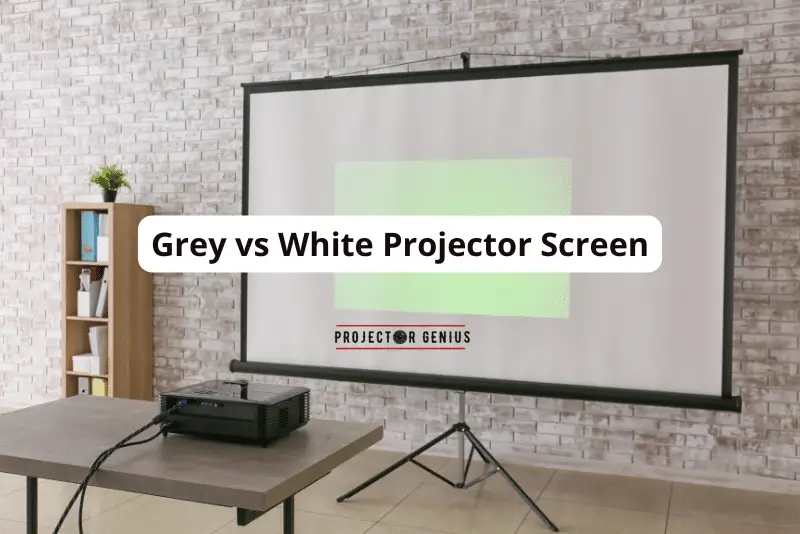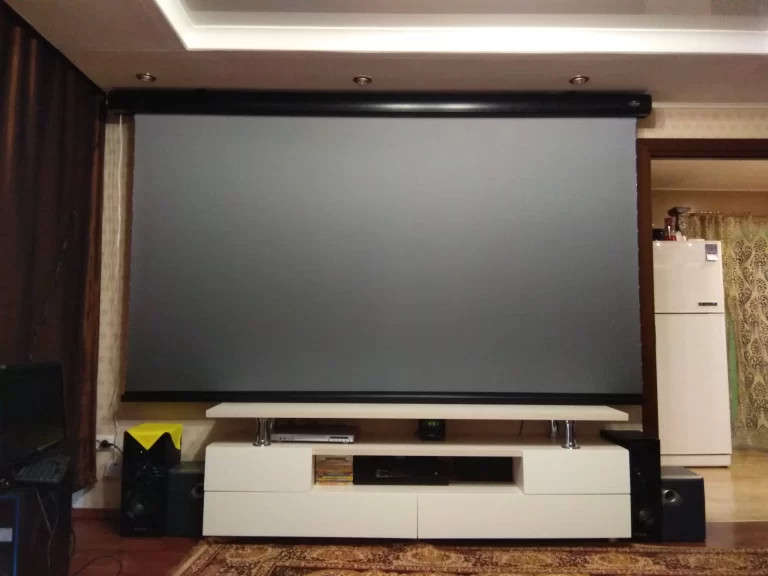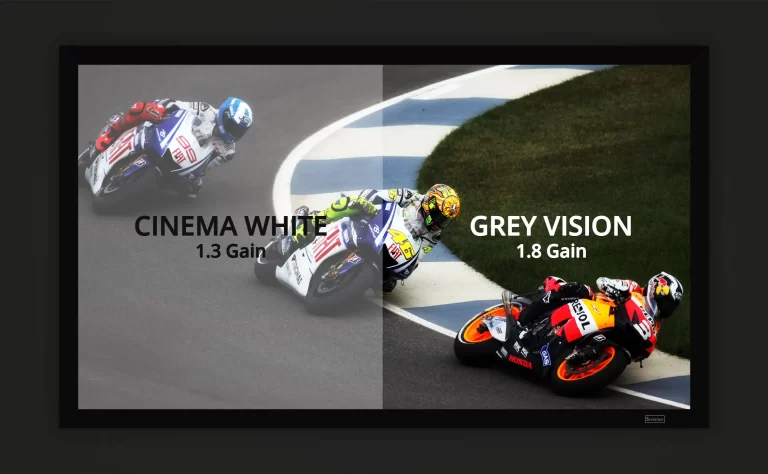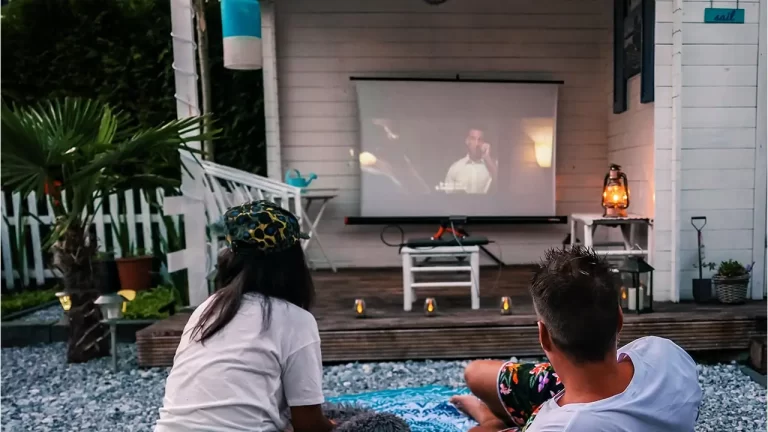Grey vs White Projector Screen [2023 Detailed Comparison]
-
 Written by:
Kristy Roger
Written by:
Kristy Roger
- Last Updated:
When diving into the world of projector screens, one debate often surfaces: Grey vs White Projector screens. Now, I’ve sifted through a ton of data, and I’ll be straight with you – there’s no one-size-fits-all answer.
Both types have their merits and drawbacks, and the best choice of screen often boils down to your specific needs, environment, and budget.
In this discussion, we’ll cut through the marketing jargon and get down to the nitty-gritty of what each type offers, their strengths, weaknesses, and which might be the best fit for your setup. Let’s dive in.

I recommend using the Table of Contents to quickly access the information you need.
My article is designed to cater to home cinema users of all levels, from Beginners to Advanced enthusiasts.
Table of Contents
What is a Grey Projector Screen?
Grey projector screen is essentially a screen designed to enhance contrast and improve the overall viewing experience. Unlike traditional white screens, which are known for their color accuracy, grey screens have a slightly darker shade. This grey tint helps absorb ambient light, making it an excellent choice for rooms with less-than-ideal lighting conditions.
Picture it like this: if you’ve got a room with a fair bit of light coming in, a grey screen can help maintain those deep blacks and bring out the details in your visuals. It’s like putting on sunglasses for your projector! This can really enhance the overall clarity and depth of your image, creating a more immersive viewing experience.
One thing to keep in mind, though, is that while grey screens are fantastic for contrast, they might not reproduce colors as accurately as their white counterparts.
What is a White Projector Screen?
A white projector screen is like the classic, all-around good guy in the world of projection. It’s exactly what it sounds like – a screen that’s primarily white in color. This is the go-to option for most setups, especially those where color accuracy is a top priority.
White screens are excellent at faithfully reproducing colors, which makes them a popular choice for professional environments and home theaters where you want to experience visuals in their truest form. They also excel at preserving brightness and contrast, which is crucial for ensuring a clear and vibrant image.
One of the standout features of a white screen is its wider viewing angles. This means that even if you’re not sitting dead center, you’re still going to get a great view. It’s perfect for accommodating larger audiences or spaces where not everyone can be directly in front of the screen.
Grey vs White Projector Screen
Color Contrast
When it comes to color contrast, grey screens really shine. They’re like the unsung heroes in darker rooms. The slight grey tint helps bring out deeper blacks, creating a more cinematic experience. White screens, on the other hand, are good all-rounders, but they might not give you that extra punch in contrast.
Picture Quality
White screens are like the reliable friend who always delivers accurate colors. They excel in color reproduction, making them great for professional settings or if you’re a stickler for precise visuals. Grey screens, though fantastic for contrast, might not give you the same level of color accuracy.
Ambient Light Performance
In a room with challenging lighting conditions, a grey screen is your go-to. It’s like having a shield against ambient light. The grey tint helps absorb unwanted light, maintaining a crisp image. White screens are solid performers too, but in rooms with lots of natural light, they might not be as effective as their grey counterparts.
Viewing Angle
White screens are like the friendly hosts who make sure everyone has a good view. They offer wider viewing angles, so even if you’re not dead center, you’re still in for a treat. Grey screens might be slightly more limited in this department, so keep that in mind for larger audiences.
Price and Availability
Now, let’s talk practicality. White screens are widely available and often more budget-friendly. They’re like the practical choice that won’t break the bank. Grey screens, with their specialized features, might come with a bit more of a price tag. It’s an investment, but one that can really pay off in the right environment.
Color Saturation
If you’re into vibrant, punchy colors, white screens are your best bet. They’re like the artists’ canvas that brings out every shade brilliantly. Grey screens, while excellent for contrast, might tone down the saturation a bit. It’s a trade-off, and it really depends on your visual preferences.
Best Use Cases
So, where do these screens truly shine? For me, if I’m setting up a home theater in a room with controlled lighting, a white screen is the way to go. But if I’m dealing with a space that has a bit more ambient light, like a living room with large windows, a grey screen would be my top pick.
My Personal Preference
Personally, I lean towards a white screen. I value color accuracy and versatility, and I tend to set up my viewing environments with controlled lighting. But I have to say, I’ve seen some mesmerizing setups with grey screens in rooms where they truly work their magic. It all boils down to your specific space and what you value most in your viewing experience.
What Factors Should I Consider When Choosing Between Grey and White Screens?
1. Lighting Conditions
First things first, take a good look at your viewing environment. Is it a controlled, dimly lit room or a space with lots of natural light? Grey screens excel in rooms with ambient light, absorbing it to maintain contrast. On the other hand, white screens are great for spaces where you have more control over lighting.
2. Color Accuracy Priority
How important is color accuracy to you? If you’re a stickler for precise color representation, a white screen might be the better choice. They’re known for faithfully reproducing colors, making them ideal for professional settings or those who want visuals to be true to life.
3. Contrast Enhancement
Consider how much you value contrast. Grey screens are champions in this department. Their slight grey tint helps create deeper blacks and enhances overall contrast. This can lead to a more immersive viewing experience, especially in cinematic settings.
4. Room Size and Seating Arrangement
Think about the size of your room and how your seating is arranged. If you have a large audience or a wide seating area, a white screen with wider viewing angles might be the better fit. However, for more intimate settings, a grey screen could work wonders, especially if you want to focus on contrast.
5. Budget and Availability
Budget considerations are always important. White screens are typically more widely available and tend to be more budget-friendly. Grey screens, with their specialized features, might come with a slightly higher price tag. It’s an investment, but it can really pay off in the right environment.
Which Type of Screen is Better for Outdoor Use?
For outdoor use, a white projector screen is generally the better choice. Here’s why:
White Projector Screen for Outdoor Use:
- Brightness and Visibility: White screens are excellent at preserving brightness and contrast. This is crucial when dealing with outdoor settings where natural light can be a factor. It ensures that the image remains clear and visible even in daylight.
- Color Accuracy: White screens are known for their accurate color representation. This can be important if you’re using the screen for presentations or displaying content where color fidelity matters.
- Versatility: White screens are suitable for a wide range of content types, including presentations, movies, and live events. They provide a versatile canvas for various viewing purposes.
- Wider Viewing Angles: White screens typically offer wider viewing angles. This is advantageous when you have a larger audience spread out across an outdoor space.
While grey screens are exceptional in controlling ambient light and enhancing contrast, they might not be as effective in bright outdoor environments. Therefore, for outdoor use, a high-quality white screen is the preferred choice to ensure optimal visibility and color accuracy.
Which Type of Screen is Better for Indoor Use?
For indoor use, the choice between a grey and white projector screen depends on various factors. Here’s a breakdown to help you decide:
Grey Projector Screen for Indoor Use:
- Ambient Light Control: If your indoor environment has significant ambient light, such as windows or other light sources that are challenging to control, a grey screen can be highly beneficial. It absorbs ambient light, helping to maintain contrast and image quality.
- Enhanced Contrast: Grey screens are designed to enhance contrast by preserving darker blacks. This can lead to a more immersive viewing experience, especially in settings like home theaters or rooms where a cinematic experience is desired.
- Viewing Environment: Consider the lighting conditions in the room. If the room tends to be darker or you have control over the lighting, a white screen may suffice. However, if the room has a fair amount of ambient light, a grey screen might be the better option.
White Projector Screen for Indoor Use:
- Color Accuracy: White screens are known for their accurate color representation. They faithfully reproduce colors, making them suitable for professional settings, presentations, or any scenario where precise color fidelity is crucial.
- Versatility: White screens work well for a wide range of content types, from movies to presentations. They provide a neutral canvas that showcases visuals in their truest form.
- Wider Viewing Angles: White screens typically offer wider viewing angles. This can be advantageous in indoor settings where you may have a larger audience or viewers seated at different angles from the screen.
In summary, for indoor use, consider the lighting conditions and the type of content you’ll be projecting. If you have control over the lighting and color accuracy is a priority, a white screen is likely the better choice. If you’re dealing with ambient light and want to enhance contrast, especially for a cinematic experience, a grey screen might be the way to go.
Which is good for eyes White or Grey Projector Screen?
In my experience, a white projector screen tends to be gentler on the eyes. Why? Well, it all comes down to color accuracy. White screens are fantastic at reproducing colors faithfully. This means you’re seeing visuals in their truest form, which can be easier on the eyes, especially during longer viewing sessions.
Grey screens, while excellent for contrast and ambient light control, might not provide the same level of color accuracy. In some cases, this could lead to slight shifts in color tones, which might not be as comfortable for extended viewing.
So, if you’re someone who values a true-to-life visual experience and wants to go easy on those peepers, a white screen is probably your best bet. After White, Black projector screen is good!
FAQs:
Does the brand or quality of the screen make a significant difference?
Yes, the brand and quality of a projector screen can indeed make a noticeable difference. Reputable brands often invest in research and materials that result in better image clarity, color accuracy, and overall screen performance. Quality screens tend to offer smoother surfaces, resist wrinkles, and last longer, which can significantly enhance your viewing experience.
On the other hand, lower-quality screens may compromise on these aspects, impacting the enjoyment and longevity of your screen investment. So, it’s often worth considering both the brand and quality when choosing a projector screen.
Which Type of Screen is More Expensive?
Grey projector screens are generally more expensive than white screens. The higher cost of grey screens is attributed to their specialized features aimed at enhancing contrast and handling ambient light. These screens are designed with advanced technology and materials that contribute to their premium price tag.
While white screens are more widely available and cater to a broader market, grey screens, with their specific benefits, tend to come with a slightly higher price. It’s important to view this as an investment, especially if you’re dealing with challenging lighting conditions where a grey screen’s capabilities can truly shine.
Final Thoughts
In conclusion, the choice between a grey and white projector screen ultimately hinges on several crucial factors. Grey screens excel in environments with challenging lighting conditions, offering enhanced contrast and absorption of ambient light. This makes them ideal for settings where controlling light is a concern, such as in outdoor or brightly lit rooms.
On the other hand, white screens are the go-to option for situations where color accuracy and versatility are paramount. They faithfully reproduce colors and work well in controlled indoor environments.
Author of this Post:

Kristy Roger
Home Cinema Consultant & Tech Enthusiast
Holding a background in Industrial and Electrical Technology from the University of Alberta, Kristy has spent 5+ years consulting on home theater products at a top electronics firm. As a certified Technical Professional with Lean Six Sigma credentials, Kristy expertise ranges from projector nuances to hands-on experience with leading models. Kristy have been sharing her knowledge online for two years, blending professional insights with personal experiences from her own home cinema setup. Off the screen, She is a dedicated mom to Jerry, Ryan, and our two pups, Cuddle and Paw.






